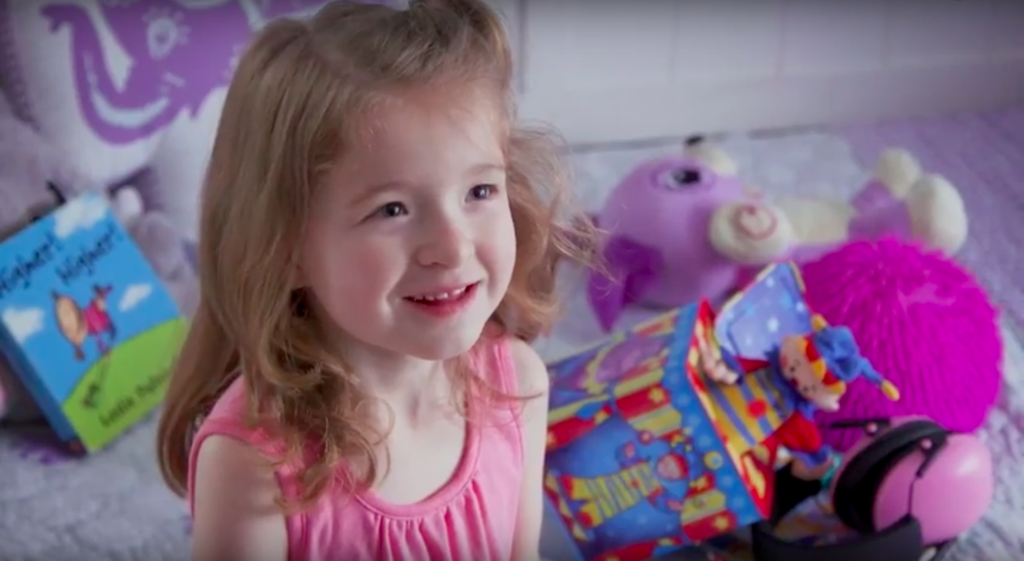“Morgan is so expressive. She smiles and she lights up the room. She just loves watching what’s happening and singing songs.” said Morgan’s mother, Trish.
Morgan, now 5 years old, was born to two thrilled and loving parents, seemingly healthy.
“We came home and had many months of pure bliss. We were just in love with our perfect little girl. We had no indication of any problem,” Trish said.
After a few months, they noticed she wasn’t developing at the expected pace—she just wasn’t growing. Near the 6-month mark, her parents and doctors noticed she was missing other milestones and began considering early intervention. As she approached her first birthday, all parts of her development were delayed. They began looking for additional help to treat Morgan’s symptoms and for a geneticist, who they hoped could give them some answers.
“It seemed like everyone just kind of descended on our house all at once,” Trish said.
Caring for Morgan
Morgan began seeing multiple doctors and specialists: physical therapists, occupational therapists, speech therapists, a special educator, and more. Initial genetic tests didn’t reveal any clues. After 3 years of tests and searching, they still didn’t know why their daughter was falling far behind her peers.
Then their developmental pediatrician suggested whole exome sequencing (WES), a more comprehensive and robust genetic test that had only recently become available. WES revealed a single-point mutation in a gene called HNRNPH2.
Finally, they had an answer, but little was known about this ultra-rare gene mutation. There was no treatment or cure. There wasn’t even a support community of others with the same condition. Morgan is one of a handful of people in the world ever found with this genetic variation. No one could explain what her future might look like. They were devastated by the diagnosis but they hoped they could help Morgan by finding other children with the same condition.
The Yellow Brick Road Project Partners with FDNA
Morgan’s parents helped found the Yellow Brick Road Project and began working with FDNA to identify more children like Morgan.
“We co-founded the Yellow Brick Road Project to advance research of rare diseases. More immediately, we wanted to identify and support families like ours and help doctors to reach diagnoses more quickly. So, we partnered with Boston-based FDNA who have a facial analysis technology called Face2Gene,” Trish said.
At the date of this publication, more than 20 girls with the same HNRNPH2 mutation have been identified due to the efforts of the Yellow Brick Road Project, with hopes of more with FDNA’s help. Some of these families, like Morgan’s parents, spent years searching for answers.
The collaboration with FDNA has resulted in Face2Gene being trained to recognize HNRNPH2-related symptoms and facial characteristics. The application is used by doctors at more than 2,000 clinical sites globally to evaluate patients, so it is expected that the road to reach a diagnosis can now be much shorter.
“You cannot know 7,000 disorders. Thanks to the new technologies, we are learning all of the time. The face is one of the pieces of the puzzle to reach the diagnosis,” said Dr. Annick Raas-Rothschild, Director at the Institute for Rare Diseases, Sheba Medical Center.
Accelerating Advancements for Rare Diseases
For millions of children around the world, small errors in their DNA deprive them of the freedom to live full, healthy, and happy lives. In most cases, trying to identify and understand these errors is a journey, in fact, it’s an odyssey impacting these children and their families. Sharing data and working together is critical.
In this new age of technology and artificial intelligence, we are on the cusp of really understanding how to reach these elusive diagnoses, and more importantly how to develop treatments to lift this heavy burden. FDNA developed Face2Gene to help clinicians and their patients around the world. FDNA also works with researchers and advocacy groups, like the Yellow Brick Road Project, to help accelerate advancements for patients.
“The Yellow Brick Road Project has everything to do with vision. The vision of more funding going toward research and technologies, of isolated families becoming a part of a community. The vision of a better future – for all those touched by rare disease,” Trish said.
Interested in collaborating with FDNA? Contact us!
This video about Morgan’s journey first premiered at DISORDER: The Rare Disease Film Festival in Boston in October of 2017.



